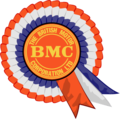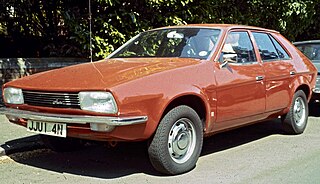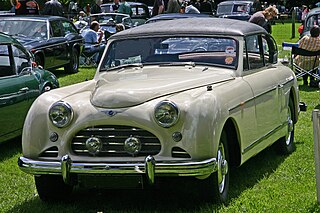The automotive industry in the United Kingdom is now best known for premium and sports car marques including Aston Martin, Bentley, Caterham Cars, Daimler, Jaguar, Lagonda, Land Rover, Lister Cars, Lotus, McLaren, MG, Mini, Morgan and Rolls-Royce. Volume car manufacturers with a major presence in the UK include Honda, Nissan, Toyota and Vauxhall Motors. Commercial vehicle manufacturers active in the UK include Alexander Dennis, Ford, IBC Vehicles, Leyland Trucks and London Electric Vehicle Company.

The British Motor Corporation Limited (BMC) was a UK-based vehicle manufacturer, formed in early 1952 to give effect to an agreed merger of the Morris and Austin businesses.

The Austin Motor Company Limited was a British manufacturer of motor vehicles, founded in 1905 by Herbert Austin. In 1952 it was merged with Morris Motors Limited in the new holding company British Motor Corporation (BMC) Limited, keeping its separate identity. The marque Austin was used until 1987. The trademark is currently owned by the Chinese firm SAIC Motor, after being transferred from bankrupt subsidiary Nanjing Automotive which had acquired it with MG Rover Group in July 2005.

British Leyland was an automotive engineering and manufacturing conglomerate formed in the United Kingdom in 1968 as British Leyland Motor Corporation Ltd (BLMC), following the merger of Leyland Motors and British Motor Holdings. It was partly nationalised in 1975, when the UK government created a holding company called British Leyland, later renamed BL in 1978. It incorporated much of the British-owned motor vehicle industry, which in 1968 had a 40 percent share of the UK car market, with its history going back to 1895.

The Princess is a large family car produced in the United Kingdom by the Austin-Morris division of British Leyland from 1975 until 1981. The car inherited a front-wheel drive / transverse engine configuration from its predecessor, the Austin/Morris 1800 range. This was still unusual in Europe for family cars of this type and gave the Princess a cabin space advantage when compared with similarly sized cars from competing manufacturers.

Longbridge plant is an industrial complex in Longbridge, Birmingham, England, currently leased by SAIC as a research and development facility for its MG Motor subsidiary. Vehicle assembly most recently stopped in 2016.

Jensen Motors Limited was a British manufacturer of sports cars and commercial vehicles in West Bromwich, England. Brothers Alan and Richard Jensen gave the new name, Jensen Motors Limited, to the commercial body and sports car body making business of W J Smith & Sons Limited in 1934. It ceased trading in 1976. Though trading resumed in 1998, Jensen Motors Limited was dissolved in 2011.

Herbert Austin, 1st Baron Austin was an English automobile designer and builder who founded the Austin Motor Company. For the majority of his career he was known as Sir Herbert Austin, and the Northfield bypass is called "Sir Herbert Austin Way" after him.

The Jensen Interceptor is a grand touring car which was hand-built at the Kelvin Way Factory in West Bromwich, near Birmingham in England, by Jensen Motors between 1966 and 1976. The Interceptor name had been used previously by Jensen for the Jensen Interceptor made between 1950 and 1957 at the Carters Green factory. Jensen had extensively used glass-reinforced plastic for the fabrication of body panels in the preceding two decades, but the new Interceptor saw a return to a steel body-shell. The body was designed by an outside firm, Carrozzeria Touring of Italy, rather than the in-house staff. The early bodies were built in Italy by Vignale, before Jensen took production in house, making some subtle body modifications.

The Morris Minor is a British economy family car that made its debut at the Earls Court Motor Show, London, in October 1948. Designed under the leadership of Alec Issigonis, more than 1.6 million were manufactured between 1948 and 1972 in three series: the Series MM, the Series II, and the 1000 series.

See Austin A40 for other A40 models.

Wolseley Motors Limited was a British motor vehicle manufacturer founded in early 1901 by the Vickers armaments combine in conjunction with Herbert Austin. It initially made a full range, topped by large luxury cars, and dominated the market in the Edwardian era. The Vickers brothers died and, without their guidance, Wolseley expanded rapidly after the war, manufacturing 12,000 cars in 1921, and remained the biggest motor manufacturer in Britain.

John Davenport Siddeley, 1st Baron Kenilworth, was a pioneer of the motor industry in the United Kingdom, manufacturing aero engines and airframes as well as motor vehicles.
Lickey Grange is a Victorian house and estate in the village of Lickey, Bromsgrove District, Worcestershire, near Birmingham, England, where the automobile manufacturer Herbert Austin lived for 31 years. It later became a residential school and is now private housing.

The Jensen C-V8 is a four-seater GT car produced by Jensen Motors between 1962 and 1966.

The Earls High School is a secondary school with academy status on Furnace Lane near the A458 in Halesowen, West Midlands. Established in 1652 and formerly Halesowen Grammar School, it also incorporates the former Halesowen Technical School.

The Jensen Interceptor made its debut in 1950 as the second car made by Jensen Motors after World War II. The car was based on Austin components with a body built by Jensen and styled by Eric Neale. The 3,993 cc straight-six engine and transmission came from the Austin Sheerline and the chassis was a lengthened version of the one used on the Austin A70 with a modified version of the independent coil sprung suspension.

John Polwhele Blatchley was a London-born car designer known for his work with J Gurney Nutting & Co Limited and Rolls-Royce Limited. He began his career as designer with Nutting in 1935, moving up to Chief Designer before leaving in 1940 to join Rolls-Royce. There he served as a draughtsman (1940–43), stylist in the car division (1943–55), and chief styling engineer (1955–69).
Mulliners Limited of Birmingham was a British coachbuilding business in Bordesley Green, with factories in Bordesley Green and Cherrywood Roads. It made standard bodies for specialist car manufacturers. In the 19th century there were family ties with founders Mulliners of Northampton and the businesses of other Mulliner brothers and cousins but it became a quite separate business belonging to Herbert Mulliner.

Jensen P66 was a model range planned by Jensen Motors in the 1960s, which was aborted after two examples were made and one was exhibited at the 1965 London Motor Show.

















